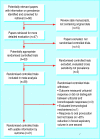Systematic review of prevalence of aspirin induced asthma and its implications for clinical practice
- PMID: 14976098
- PMCID: PMC344260
- DOI: 10.1136/bmj.328.7437.434
Systematic review of prevalence of aspirin induced asthma and its implications for clinical practice
Abstract
Objective: To reassess the prevalence of aspirin induced asthma and other issues related to the syndrome.
Data sources: Biosis, SciSearch (1990 to March 2002), Embase (1974 to March 2002), Medline (1966 to March 2002), Toxline, Derwent Drug File (1964 to March 2002), Conference Papers Index and Inside Conferences, Int'l Pharmaceutical Abstracts, Pharma-Online (1978 to March 2002).
Selection criteria: Study type, patient population, and outcome measures. Review was restricted to respiratory responses to analgesics available without prescription.
Results: The prevalence of aspirin induced asthma was highest when determined by oral provocation testing (adults 21%, 95% confidence interval 14% to 29%; children 5%, 0% to 14%) than by verbal history (adults 3%, 2% to 4%; children 2%, 1% to 3%). Cross sensitivity to doses of over the counter non-steroidal anti-inflammatory drugs was present in most patients with aspirin induced asthma: ibuprofen, 98%; naproxen, 100%; and diclofenac, 93%. The incidence of cross sensitivity to paracetamol among such patients was only 7%.
Conclusions: Aspirin induced asthma in adults is more prevalent than previously suggested. When there is a clinical necessity to use aspirin or a non-steroidal anti-inflammatory drug and there is uncertainty about safety, oral provocation testing should be performed.
Figures



Comment in
-
Aspirin induced asthma: clinical relevance of finding was not explained.BMJ. 2004 May 1;328(7447):1076; author reply 1076-7. doi: 10.1136/bmj.328.7447.1076-a. BMJ. 2004. PMID: 15117804 Free PMC article. No abstract available.
-
Aspirin induced asthma: effect size needs to be clarified.BMJ. 2004 May 1;328(7447):1076; author reply 1076-7. doi: 10.1136/bmj.328.7447.1076-b. BMJ. 2004. PMID: 15117805 Free PMC article. No abstract available.
References
-
- Szczeklik A, Gryglewski RJ, Czerniawska-Mysik G. Clinical patterns of hypersensitivity to nonsteroidal anti-inflammatory drugs and their pathogenesis. J Allergy Clin Immunol 1977;60: 276-84. - PubMed
-
- Stevenson DD. Diagnosis, prevention, and treatment of adverse reactions to aspirin and nonsteroidal anti-inflammatory drugs. J Allergy Clin Immunol 1984;74: 617-22. - PubMed
-
- Schwab JM, Schluesener HJ, Laufer S. COX-3: just another COX or the solitary elusive target of paracetamol? Lancet 2003;361: 981-2. - PubMed
-
- Stevenson DD, Simon RA. Lack of cross-reactivity between rofecoxib and aspirin in aspirin-sensitive patients with asthma. J Allergy Clin Immunol 2001;108: 47-51. - PubMed
Publication types
MeSH terms
Substances
LinkOut - more resources
Full Text Sources
Other Literature Sources
Medical
